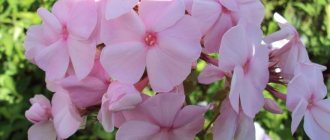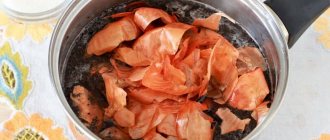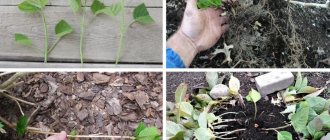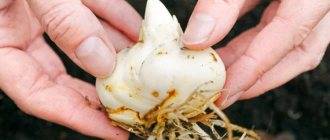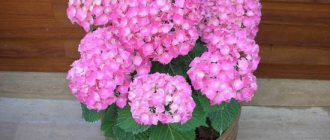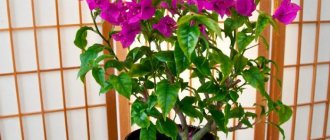Cuttings are the easiest way to propagate any type of hydrangea. Lignified cuttings take root poorly, so it is better to use annual green shoots. In this article we will tell you in detail how to grow spectacular hydrangea from cuttings.
Hydrangea can be propagated by cuttings in both spring and summer. But the most suitable time for this is mid-summer (shortly before flowering begins). Therefore, it is recommended to cut cuttings from the bush at the moment when the buds have just begun to form on the plant. But at the same time, it is important not to wait until the shoots become lignified, otherwise the cuttings will take root with difficulty.
It is best to cut shoots early in the morning. To prevent them from wilting, keep the hydrangea cuttings in water until cuttings.
How to properly propagate hydrangea by shoots and dividing the bush
One of the easiest ways to propagate hydrangea is by dividing the bush and young shoots.
Reproduction by shoots. Tree hydrangeas reproduce well by shoots. However, this method requires great attention and caution.
To do this, in the fall, remove the top layer of soil and, very carefully, so as not to damage the roots of the mother bush, separate the shoot.
The separated shoots are planted in a garden bed and left there for one or two years to grow, depending on the condition of the seedling. For the winter, the bed is covered with leaves and non-woven material.
Reproduction by dividing the bush. This propagation method is suitable for tree and broadleaf hydrangeas and is used mainly in early spring when transplanting. Before propagating hydrangea in this way, first water the bush abundantly, then dig it up and thoroughly wash the roots from the soil.
Then the bush is divided into several parts, the sections are sprinkled with coal for disinfection and the sections are immediately planted in a permanent place. When propagating hydrangeas by division, be sure to trim the ends of the shoots and slightly shorten the tips of the roots.
The video “Propagation of hydrangea in the garden” demonstrates the most popular methods:
Useful tips for gardeners
In order for your hydrangea to delight you with lush flowering, try to adhere to some rules, the implementation of which will allow the plant to feel as comfortable as possible:
- You need to choose a place on the site for the hydrangea in such a way that direct sunlight hits it in the first or second half of the day. On a hot afternoon, the plant needs shading.
- Hydrangea loves acidic soil; in extreme cases, the soil should have a neutral reaction. For acidification, you can use high-moor peat, pine sawdust, and citric acid solution.
- Cuttings root best at a temperature of 20 °C and 80% humidity.
- In the first year of planting, it is recommended to remove the developing buds to obtain the strongest, healthiest plant possible.
- You can diversify the appearance of the bush by grafting a cutting of a different variety of hydrangea onto it. With the help of grafting you will get an original plant, unlike any other.
- Hydrangea is very moisture-loving. It needs to be watered frequently and abundantly.
- Be sure to choose a zoned variety for planting. In unsuitable conditions, hydrangea will not be able to reveal all its magnificent qualities. Tree, paniculate and ground cover hydrangeas are considered the most frost-resistant.
Today, hydrangea is again at the peak of popularity. However, this magnificent shrub is quite worthy of the attention of gardeners. Using one of the listed methods of propagating hydrangea, you can get the number of new plants you need and give your site a renewed look.
Reproduction of garden hydrangea by layering
The method of propagating hydrangea by layering is ideal for tree-like, broad-leaved and petiolate species. Other forms of these plants can be propagated in this way only if the bushes are small.
To do this, young outer flexible branches are bent from the growing bush and pinned to the ground (in a hole 15 cm deep) with brackets, tying the ends of the branches to pegs. To propagate hydrangea correctly, as experienced gardeners advise, at the very bottom of the hole, on the underside of the shoot, you first need to make an oblique cut several centimeters long. Then a match is inserted into the incision - tissue damage will accelerate the formation of roots in this place.
The bases of pinned shoots are sprinkled with a light mixture of soil and peat, and the soil is regularly moistened (to conserve moisture, cover the filled hole with film or mulch).
As shown in the photo, with such propagation of hydrangeas, the cuttings eventually form their own roots, and then they can be separated from the mother plant and planted the next year:
Method of propagating hydrangea by cuttings in spring (with video)
In general, pruning of hydrangeas that bloom on the shoots of the current year is carried out before the sap flows. However, if you want to take cuttings from the bushes, then do the pruning at the beginning of sap flow, before the buds open, for better rooting (rooting rate is about 70%). With this method of cuttings (woody cuttings), the planting material is of higher quality. So, to propagate hydrangeas in the spring, in the first half of April, when you see that the plant buds have begun to develop and have become slightly swollen, this means you can prune the bushes for cuttings. Tree hydrangea begins to develop after hibernation faster than paniculata, so pruning of tree hydrangea must be done earlier.
Trim the shoots, leaving 3-4 buds on them. To propagate hydrangeas in the spring, cut cuttings from the resulting branches so that each of them has 2 nodes. Make an oblique cut under the lower bud, and a straight one above the upper one, at a distance of 2-3 cm from it. After this, plant the resulting cuttings in a greenhouse in peat-sandy soil, deepening the lower bud by 3 cm, cover with plastic wrap or a plastic bottle and water generously. Then water the cuttings every day depending on the dryness of the soil.
For paniculate hydrangea, cut back last year's shoots by a third of their length. From the cut branches, cut cuttings according to a tree-like pattern and plant them in the greenhouse in the same way. Transplant rooted cuttings into open ground in the summer.
Watch the video of hydrangea propagation in spring to better imagine how this agricultural technique is performed:
Features of the plant
The rounded bush is formed by thin shoots that are covered with a small amount of fluff. The ovoid leaves are about 20 cm long and are painted in a bright green shade. Their lower surface has a light green-bluish color. The leaves are attached to the branches using long and thin petioles. They are located on the shoots opposite each other (the so-called opposite arrangement).
Quite large inflorescences with a diameter of almost 15 cm, shaped like a shield, are formed from whitish flowers about 2 cm wide. Lush flowering continues from mid-July until October. The seeds ripen in October.
This type of hydrangea is different:
- fairly good winter hardiness,
- because it actively grows after winters with severe frosts,
- high percentage of rooting of cuttings.
| Tree hydrangea develops best in soils with a slightly acidic reaction (pH at 5.0), but is more tolerant of the presence of lime in the soil than other varieties of hydrangeas. |
Based on this species, several varieties have been created that can be purchased in nurseries in our country:
- The well-known and very popular variety “Annabelle” attracts attention with large and heavy snow-white inflorescences up to 25 cm wide, which can lie down. This fairly unpretentious and fast-growing plant reaches a height of 1.0 to 1.5 meters and a width of almost 3 meters. Flowering continues throughout the summer (three months).
- Grandiflora bushes are liked for their spectacular appearance and long-lasting powerful flowering. Lush inflorescences change color several times during flowering. When blooming, the inflorescences are painted in a delicate greenish tint, then they become snow-white. By the end of flowering, the inflorescences take on a light whitish-cream hue. The height of the bush is about 2 meters, and the width can reach almost 3 meters.
- The variety "Invincibelle" or "Pink Annabelle" is created on the basis of "Annabelle". This is the first tree hydrangea to be painted pink. In addition to the color, it is interesting because if you prune the bush after the first flowering, the plant will bloom again in 6 weeks. At the International Exhibition of Nursery Products "Plantarium 2011" this variety received a bronze medal.
- “Strong Annabelle” or “Incrediball” is also obtained using the “Annabelle” variety, but its white inflorescences, blooming on strong and strong branches, are not damaged by wind and rain. Flowering lasts from June to September. This variety has received an award from an international competition.
Propagation of hydrangea by woody cuttings in summer
Hydrangea cuttings are usually carried out in the summer, from mid-June to mid-July. An important point is to retain moisture in the cut stems, since this determines how productive the rooting will be.
Experienced gardeners recommend preparing planting material for propagating hydrangeas in the summer like this: cut off the branches in cloudy weather early in the morning and immediately divide them into cuttings. If planting is planned later, place them in water. Cut off the top of the branch with the bud. Divide the remaining stem into parts so that each of them has 2 to 3 pairs of leaves. Cut the top leaves by half and remove the bottom leaves. For two hours, place the shoots in a solution that stimulates root formation - root, zircon or heteroauxin. You can also prepare your own root former by dissolving a teaspoon of honey in water (200 g). The leaves should not touch the stimulant.
Or you can not use any stimulants at all - the roots are formed that way. When propagating hydrangea by cuttings, before planting in the ground, the upper cut is treated with brilliant green or garden varnish for disinfection. At a temperature of 15-25 degrees, hydrangea cuttings usually take root after a month. However, in summer cuttings the root system often does not have time to develop well, which can lead to their death in winter. Therefore, young plants need to be carefully covered before the first winter, protecting them from frost.
Also, when propagating hydrangea from lignified cuttings, they practice growing roots in water. Usually it takes 20-30 days. After the roots reach 3 centimeters in length, they are planted in the ground. However, this method is not very successful - often the lower tips of the cuttings rot and the plant dies.
Planting in open ground
There are a few things to consider
when choosing a location First of all, you should not place tree hydrangea next to woody plants, as it will feel a lack of moisture. Tree hydrangea will feel most comfortable in partial shade. Staying in a place that is too sunny is only possible if there is excess moisture. The best option is a shaded place where the sun penetrates only in the morning and evening. West or east windows are best suited .
Maintaining temperature conditions is very important for the healthy growth of hydrangeas. It is necessary to prevent hydrangea from being exposed to very low or high temperatures, as this can lead to negative consequences. The optimal temperature in winter is 4-9°C , the rest of the time – no higher than 20°C .
It is frost-resistant and can withstand temperatures as low as -15°C. If the upper part of the plant is damaged during frost, it will quickly recover when the weather warms up.
Hydrangea needs the right soil to grow. It should be:
- Acidified;
- Enriched with peat, humus or mineral fertilizers;
- Well compacted;
- Moisturized;
- Have good drainage.
- Ready-made soil can be purchased in specialized stores. Universal will do. It can be enriched with the necessary substances at home.
To acidify the soil, add crushed pine bark, sawdust or organic waste.
Method of propagating hydrangea by cuttings in autumn
You can also take cuttings from large-leaved hydrangea bushes in the fall in September-October, before the winter shelter of the bushes. To propagate hydrangeas in the fall, cut the shoots and cut the cuttings so that each has 2 leaf nodes, remove the lower leaves, cut the upper ones in half, leaving 1 cm of shoot from the lower bud and the upper leaf. Dip the cutting with the lower cut into a rooting accelerator, then deepen it into garden soil in pots up to the top leaves.
When propagating hydrangeas in the fall, compact the soil around the cutting well and coat the top cut with brilliant green for disinfection. Several cuttings can be planted in pots for rooting, depending on the volume. After planting the cuttings in the ground to a depth of 1 cm, add the Glyokladina tablet - it will protect the plant from root rot. Place the pot in a clear plastic bag, tie it and place it on the windowsill. In winter, when the weather is frosty, protect the pots from the cold with newspapers and make sure that there is no ice formation inside the bags.
When propagating garden hydrangea, cuttings need to be ventilated several times a week, but for a short time, so that the young leaves do not have time to dry out. Be sure to remove old fallen leaves. In spring, in cloudy weather, take the pots outside (balcony) to harden the plants. Determine readiness for planting in open ground when the leaves curl and droop.
The video “Propagation of hydrangea by cuttings” shows how this event is carried out correctly:
Photo
See more photos of hydrangea below:
Garden hydrangea often becomes a “target” of various diseases and pests. It is important not only to recognize the onset of damage in time and take measures to improve its health, but also to review the rules for caring for the plant in order to prevent problems from reoccurring.
Folk method of propagating hydrangeas
In the spring, they acquire strong young hydrangeas, which it is advisable to propagate. A healthy hydrangea with a closed root system (in a pot) develops well over the season; By autumn, the plant has formed good roots and strong shoots. At the end of August or at the beginning of September, the entire hydrangea bush removed from the pot is buried (horizontally) with loose fertile soil. First, carefully remove all weak and immature shoots, inflorescences and leaves from the bush.
When sprinkled with earth, the hydrangea rhizome itself should be buried below the shoots of the bush. That is, you need to lay the hydrangea bush with its roots down in the dug trench, placing it at a slight slope (about 35 degrees).
When the hydrangea bush is correctly placed, cover the rhizome of the plant with soil and compact it for reliable contact with the roots; water. Add a little more soil to the rhizome and compact it again.
When the hydrangea roots are securely closed, all that remains is to place each hydrangea branch separately (in a fan) in the trench, and then cover the entire bush with soil on top. In the spring, when the soil warms up, young shoots will emerge from this completely buried hydrangea bush. As many individual stems will sprout - future bushes with independent roots - as there were buds on the mother bush. All that remains is to divide the hydrangea bush into sections and plant them. As a rule, all young hydrangea bushes formed using this method bloom in the same year.
This technique can reliably protect flower buds in the ground from frost, and multiply the bush of your favorite plant exponentially.
Watch the video on how to propagate hydrangea in the garden in different ways:


